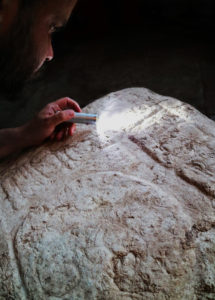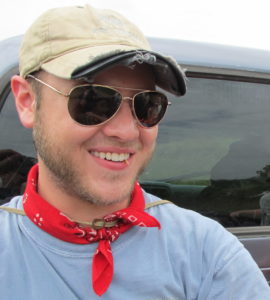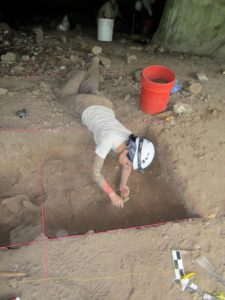Dr. Gabriel Wrobel is an associate professor in the Department of Anthropology at Michigan State University, specializing in bioarchaeology. His research with the CBAS project focuses on documenting the many cave and rockshelter mortuary sites in the study region, centering on questions related to understanding the particular uses of specific sites by investigating the nature and significance of mortuary variability. In the field, Gabe and his students conduct excavation of in situ mortuary contexts, reconstructing mortuary pathways through documentation of perimortem body treatments and of subsequent movement and alteration of bone resulting from both intentional and taphonomic processes. Subsequent skeletal analyses conducted in the Michigan State University Bioarchaeology Laboratory in East Lansing focus on aspects of social identity. Studies documenting sex and age distributions, health profiles, and dental and cranial modification practices at different sites suggest that variability in the mortuary use of caves and rockshelters can be attributed to various social, political, and temporal factors. Thus, skeletal and mortuary studies provide an important source of data informing CBAS’s broader research aimed at understanding sociopolitical and economic organization of the region.
Dr. Shawn Morton is an anthropological archaeologist interested in the development of early civilizations, particularly of the urban societies of the Maya Area. Much of his work has focused on aspects of public performance and ritual within the ancient cityscape and broader landscape, including extensive work in the deep cave contexts of Belize. Shawn is also interested in modifying and applying techniques of analysis and modeling used in the study of modern urban contexts and exploring their utility in the ancient context. He is currently employed as a Lecturer in the Department of Anthropology at Northern Arizona University, is a Research Associate at Michigan State University, and an Adjunct Assistant Professor at the University of Calgary.
 Dr. Kip Andres has been involved in archaeology since 1992 and has been conducting field research in Central America since 1996. His doctoral fieldwork focused on the relationship between changing architectural patterns and sociopolitical organization at the ancient Maya center of Chau Hiix, Belize and he has continued to pursue related interests in the Caves Branch River Valley. In addition to his involvement in Mesoamerican archaeology, he has participated in cultural resource management and archaeological research in the American midwest, southwest, and southeast. His current research focuses on urbanism, issues of form and function in the built environment, spatial analysis, the role of monumental architecture in sociopolitical transformations in complex societies, and the rise and fall of ancient civilizations. On the Central Belize Archaeological Survey Project, he is particularly interested in developing an improved understanding of sociopolitical patterns as reflected at Tipan and the valley’s surrounding surface sites that allow for comparison with ancient communities in better understood areas of the southern lowlands in the period leading up to the so-called Classic Maya “collapse.”
Dr. Kip Andres has been involved in archaeology since 1992 and has been conducting field research in Central America since 1996. His doctoral fieldwork focused on the relationship between changing architectural patterns and sociopolitical organization at the ancient Maya center of Chau Hiix, Belize and he has continued to pursue related interests in the Caves Branch River Valley. In addition to his involvement in Mesoamerican archaeology, he has participated in cultural resource management and archaeological research in the American midwest, southwest, and southeast. His current research focuses on urbanism, issues of form and function in the built environment, spatial analysis, the role of monumental architecture in sociopolitical transformations in complex societies, and the rise and fall of ancient civilizations. On the Central Belize Archaeological Survey Project, he is particularly interested in developing an improved understanding of sociopolitical patterns as reflected at Tipan and the valley’s surrounding surface sites that allow for comparison with ancient communities in better understood areas of the southern lowlands in the period leading up to the so-called Classic Maya “collapse.”
Dr. Amy Michael recently completed her Ph.D. at Michigan State University. Her dissertation, a comparison study of burials from caves, rockshelters, and surface sites, represents the largest sample in a dental histology study to date in the Maya region. Her research interests include using bone and dental histology to explore mortuary variation, refinement of micro-spatial histological sampling methods, and the relationship between social identity, health, and mortuary location in Central Belize. Amy has also worked in the American Midwest excavating on MSU’s campus, as well as excavating house structures and a large civic-ceremonial center at the prehistoric site of Morton Village in Illinois. Additionally, she was involved in a project in Albania excavating Bronze Age burial mounds. She has been a staff member on the CBAS project since 2011 working at the sites of Sapodilla Rockshelter, Actun Kabul, Caves Branch Rockshelter, and Wishing Well Cave. With experience in forensic, archaeological, and paleoanthropological laboratories, Amy is trained as an osteologist and microscopist. Her current research focuses on the histology of pathological bone, refinement of sampling protocol for age at death estimations using human ribs, and the exploration of bone and tooth caches at a cave site in Belize.
Dr. Christophe Helmke’s primary  research interests are Maya archaeology and epigraphy. Other interests include ancient Maya cave utilization, household archaeology, Mesoamerican writing systems and rock art, as well as Amerindian mythologies. The majority of his research has focused on Mesoamerica, especially on the Classic Maya, the cultures of the Epiclassic in Central Mexico as well as Teotihuacan. Christophe is Associate Professor of American Indian Languages and Cultures at the Institute of Cross-cultural and Regional Studies, University of Copenhagen, Denmark.
research interests are Maya archaeology and epigraphy. Other interests include ancient Maya cave utilization, household archaeology, Mesoamerican writing systems and rock art, as well as Amerindian mythologies. The majority of his research has focused on Mesoamerica, especially on the Classic Maya, the cultures of the Epiclassic in Central Mexico as well as Teotihuacan. Christophe is Associate Professor of American Indian Languages and Cultures at the Institute of Cross-cultural and Regional Studies, University of Copenhagen, Denmark.
 Jack Biggs is a Ph.D. student at Michigan State University in East Lansing, Michigan. His research interests lie in bioarchaeology and focus on the ancient Maya. Specifically, he is interested in the growth and development of the skeleton and how cultural, environmental, and biological factors influence these processes, particularly pertaining to subadults. Additionally, he is interested in the social identities of subadults and how they affect and are affected by the adult world, mostly within the Late Classic period. Jack has excavated at the historical site of Washington-on-the-Brazos in Texas, the Bronze Age site of Gournia on the island of Crete, Greece uncovering palatial residences, plazuela structures at the sites of Lower Dover and Baking Pot in Belize with the Belize Valley Archaeological Reconnaissance Project, and helped supervise excavations at the Caves Branch Rockshelter in 2015 with the CBAS Project. During the 2017 field season, he will be co-supervising excavations at the Sapodilla Rockshelter with Amy Michael.
Jack Biggs is a Ph.D. student at Michigan State University in East Lansing, Michigan. His research interests lie in bioarchaeology and focus on the ancient Maya. Specifically, he is interested in the growth and development of the skeleton and how cultural, environmental, and biological factors influence these processes, particularly pertaining to subadults. Additionally, he is interested in the social identities of subadults and how they affect and are affected by the adult world, mostly within the Late Classic period. Jack has excavated at the historical site of Washington-on-the-Brazos in Texas, the Bronze Age site of Gournia on the island of Crete, Greece uncovering palatial residences, plazuela structures at the sites of Lower Dover and Baking Pot in Belize with the Belize Valley Archaeological Reconnaissance Project, and helped supervise excavations at the Caves Branch Rockshelter in 2015 with the CBAS Project. During the 2017 field season, he will be co-supervising excavations at the Sapodilla Rockshelter with Amy Michael.
 Jill Jordan is a doctoral student in the Anthropology Department at the University of New Mexico. She received her MA in 2008 from the University of Mississippi under the direction of Dr. Gabriel Wrobel. This research focused on the timing and development of the Late to Terminal Classic site of Deep Valley in the Caves Branch River Valley. Her current work with CBAS is focused on determining political and/or economic affiliations between the inhabitants of the Caves Branch River Valley and surrounding regions based on stylistic and technological ceramic attributes. In addition to CBAS, she also works as a ceramic analyst with the Uxbenka Archaeological Project (UAP) and Belize Valley Archaeological Reconnaissance Project (BVAR) for her dissertation research. Her dissertation addresses learning networks and communities of practice among Late Classic, non-elite Maya craft producers at Baking Pot and Uxbenká, Belize. Her research interests include ceramic analyses, ceramic technology, domestic craft production, regional economic systems, intracommunity household organization, thin section petrography, sedimentary geology and ancient Maya acquisition, manipulation, and use of clay and rock resources for ceramic production.
Jill Jordan is a doctoral student in the Anthropology Department at the University of New Mexico. She received her MA in 2008 from the University of Mississippi under the direction of Dr. Gabriel Wrobel. This research focused on the timing and development of the Late to Terminal Classic site of Deep Valley in the Caves Branch River Valley. Her current work with CBAS is focused on determining political and/or economic affiliations between the inhabitants of the Caves Branch River Valley and surrounding regions based on stylistic and technological ceramic attributes. In addition to CBAS, she also works as a ceramic analyst with the Uxbenka Archaeological Project (UAP) and Belize Valley Archaeological Reconnaissance Project (BVAR) for her dissertation research. Her dissertation addresses learning networks and communities of practice among Late Classic, non-elite Maya craft producers at Baking Pot and Uxbenká, Belize. Her research interests include ceramic analyses, ceramic technology, domestic craft production, regional economic systems, intracommunity household organization, thin section petrography, sedimentary geology and ancient Maya acquisition, manipulation, and use of clay and rock resources for ceramic production.


